DeLonghi DE609MP User Manual

DE’LONGHI
COOKING
INSTALLATION and SERVICE INSTRUCTIONS
USE and CARE INSTRUCTIONS
DE609MP
PYROLYTIC BUILT-IN OVEN
distributed by
DeLonghi Australia Pty Ltd
DeLonghi New Zealand Ltd

Dear Customer,
Thank you for having purchased and given your preference to our product.
The safety precautions and recommendations reported below are for your own safety and that of others. They will also provide a means by which to make full use of the features offered by your appliance.
Please keep this booklet in a safe place. It may be useful in future, either to yourself or to others in the event that doubts should arise relating to its operation.
This appliance must be used only for the task it has explicitly been designed for, that is for cooking foodstuffs. Any other form of usage is to be considered as inappropriate and therefore dangerous.
The manufacturer declines all responsibility in the event of damage caused by improper, incorrect or illogical use of the appliance or be faulty installation.
This appliance has been designed and constructed in accordance with the following codes and specifications:
AS/NZS 60335.1 General Requirements for Domestic electrical appliances
AS/NZS 60335.2.6 Particular Requirements for Domestic electrical cooking appliances AS/NZS CISPR 14.1 Electromagnetic Compatibility Requirements.
PRODUCT LABEL
2

Important:
This appliance is designed and manufactured solely for the cooking of domestic (household) food and is not suitable for any non domestic application and therefore should not be used in a commercial environment.
The appliance guarantee will be void if the appliance is used within a non domestic environment i.e. a semi commercial, commercial or communal environment.
FIRST USE OF THE OVEN
It is advised to follow these instructions:
■■ Furnish the interior of the oven as described at chapters “USE AND CARE” and “CLEANING AND MAINTENANCE”.
■■ Switch on the empty oven on max to eliminate grease from the heating elements.
■■ Let the oven cool down and clean the interior of the oven with a cloth soaked in water and neutral detergent, then dry carefully.
IMPORTANT PRECAUTIONS AND RECOMMENDATIONS FOR USE OF ELECTRICAL APPLIANCES
Use of any electrical appliance implies the necessity to follow a series of fundamental rules. In particular:
■■ Never touch the appliance with wet hands or feet.
■■ Do not operate the appliance barefooted.
■■ The appliance is not intended for use by young children or infirm persons without supervision.
■■ Young children should be supervised to ensure they do not play with the appliance.
The manufacturer cannot be held responsible for any damages caused by improper, incorrect or illogical use of the appliance.
3
IMPORTANT PRECAUTIONS AND RECOMMENDATIONS
After having unpacked the appliance, check to ensure that it is not damaged and that the oven door closes correctly. In case of doubt, do not use it and consult your supplier or a professionally qualified technician.
Packing elements (i.e. plastic bags, polystyrene foam, nails, packing straps, etc.) should not be left around within easy reach of children, as these may cause serious injuries.
■■ Some appliances are supplied with a protective film on steel and aluminium parts. This film must be removed before using the appliance.
■■ Do not attempt to modify the technical characteristics of the appliance as this may become dangerous to use.
■■ Do not carry out cleaning or maintenance operations on the appliance without having previously disconnected it from the electric power supply.
■■ After use, ensure that the knobs are in the off position. ■■ Keep children away from the appliance when it is in use.
■■ WARNING: Accessible parts will become hot when in use. To avoid burns and scalds, young children should be kept away.
■■ Young children should be supervised to ensure that they do not play with the appliance.
■■ Children, or persons with a disability which limits their ability to use the appliance, should have a responsible person to instruct them in its use. The instructor should be satisfied that they can use the appliance without danger to themselves or their surroundings.
■■ During and after use of the appliance, certain parts will become very hot. Do not touch hot parts. Care should be taken to avoid touching heating elements inside the oven.
■■ Make sure that electrical cables connecting other appliances in the proximity of the oven cannot become entrapped in the oven door.
■■ WARNING: When correctly installed, your product meets all safety requirements laid down for this type of product category.
However special care should be taken around the rear or the
4
underneath of the appliance as these areas are not designed or intended to be touched and may contain sharp or rough edges, that may cause injury.
■■ Do not line the oven walls with aluminium foil. Do not place baking trays or the drip tray on the base of the oven chamber.
■■ Fire risk! Do not store flammable material in the oven.
■■ Always use oven gloves when removing the shelves and food trays from the oven whilst hot.
■■ Do not hang towels, dishcloths or other items on the appliance or its handle – as this could be a fire hazard.
■■ Clean the oven regularly and do not allow fat or oils to build up in the oven base or tray. Remove spillages as soon as they occur.
■■ Do not stand on the open oven door.
■■ Always stand back from the appliance when opening the oven door to allow steam and hot air to escape before removing the food.
■■ Safe food handling: Leave food in the oven for as short a time as possible before and after cooking. This is to avoid contamination by organisms which may cause food poisoning. Take particular care during warmer weather.
■■ Pyrolysis cycle - IMPORTANT! The pyrolysis cycle must only be performed with the oven empty; so, before starting the cycle take all the accessories (shelves, baking tray and anti-grease filter) out of the oven cavity and dry any traces of overflowed liquid.
■■ The manufacturer declines all liability for injury to persons or damage to property caused by incorrect or improper use of the appliance.
■■ WARNING: Taking care NOT to lift the oven by the door handle.
■■ IMPORTANT NOTE: This appliance shall not be used as a space heater, especially if installed in marine craft or caravans.
■■ Do not operate your appliance by means of an external timer or separate remote-control system.
■■ This appliance is for domestic use only.
5

INSTALLATION
CAUTION:
■■ This appliance must be installed in accordance with these installation instructions. ■■ This appliance shall only be serviced by authorised personnel.
■■ This appliance is to be installed only by an authorised person in compliance with the current electrical regulations and in observation of the instructions supplied by the manufacturer.
Failure to comply with this condition will render the guarantee invalid.
■■ Incorrect installation, for which the manufacturer accepts no responsibility, may cause personal injury of damage.
■■ Always disconnect the appliance from mains power supply before carrying out any maintenance operations or repairs.
FITTING REQUIREMENTS
■■ The oven can be fitted in standard units, 60 cm width and depth.
■■ Installation requires a compartment as illustrated in figures 1a and 2a.
■■ Fitting the oven into a base: Arrangements should be made for an adequate supply of the air to the oven to avoid overheating (fig. 1b).
■■ Fitting the oven into a column: It is necessary that the oven is provided with a chimney as per fig. 2b. If the column unit reaches the ceiling an outlet must be provided through which air can flow to the outside
■■ On the lower side, the oven must lay on supports standing the oven weight.
■■ Remember the housing should not be free standing but be secured to the wall and/or adjacent fittings.
■■ We would point out that the adhesive which bonds the plastic laminate to the furniture must withstand temperatures not less than 150° C to avoid delamination.
■■ The walls of the units must be capable of resisting temperatures of 75 °C above room temperature.
■■ Do not seal the oven into the cabinetry with silicone or glue; this makes future servicing difficult. Delonghi will not cover the costs of removing the oven, or of damage caused by this removal.
■■ The walls surrounding the oven must be made of heat-resistant material. ■■ WARNING: Taking care NOT to lift the oven by the door handle.
WARNING
When correctly installed, your product meets all safety requirements laid down for this type of product category.
However special care should be taken around the rear or the underneath of the appliance as these areas are not designed or intended to be touched and may contain sharp or rough edges, that may cause injury.
IMPORTANT
Some environmental factors and cooking habits can cause condensation in and around the oven during use. To protect surrounding cabinetry from possible damage caused by frequent or excessive condensation, we recommend moisture-proo- fing the oven cavity.
6
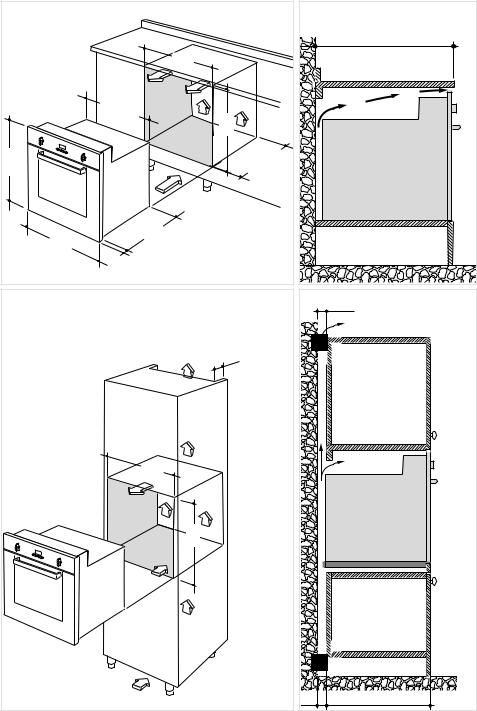
Figure 1a |
|
|
|
|
|
|
560 |
|
536 |
min |
195 |
|
|
||
|
|
|
|
49 |
|
|
min |
5 |
|
|
550 |
|
|
|
|
594 |
|
|
540 |
|
|
|
|
|
20 |
|
|
Figure 2a |
50 |
560 |
585 |
|
Figure 1b |
|
600 |
50 mm |
Figure 2b |
50 |
550 |
7
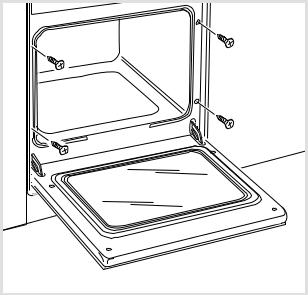
FIXING THE OVEN
Introduce the oven into the furniture opening and fix it with 4 screws (not supplied) as figure
3. It is essential that the oven rests on a surface which will support its weight, as the screw fixing is only complementary.
Note
It is essential that when installing your oven adequate air circulation is allowed for within the installation. See figures 1b - 2b.
Inadequate air circulation may greatly impair the performance of your oven and may effect adjacent cabinets due to an increase in temperature.
Caution!
Do not lift this oven by the door handle.
Adjust the hinges of furniture doors adjacent to the oven to allow a 4-5 mm gap between the furniture door and the oven frame.
Figure 3
8
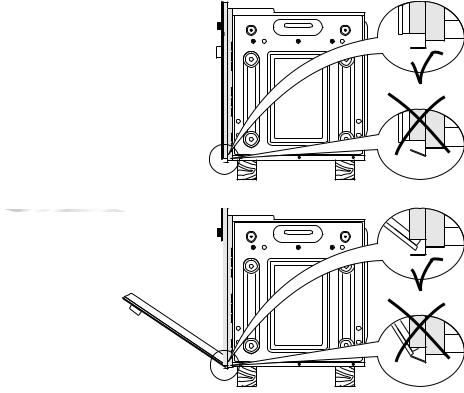
OvenVEN DOORDoor
LOWERowerTRIMrim
AIRAirFLOWFlow
Figure 4
IMPORTANT:
Please take extra care not to damage the lower trim of the oven.
Ensure the oven sits on wooden blocks or similar supports when it is removed from the carton as shown in above diagram. This will prevent any damage to the lower trim.
Should the lower trim become damaged, straighten the trim and ensure the oven door opens fully without obstruction from the lower trim.
After installation check the lower trim is still undamaged.
The space between the bottom of the door & the lower trim is important to allow proper air circulation into the oven.
The oven door should be opened slowly to it’s fully open position ensuring there is adequate clearance between the bottom of the door and the lower trim.
The manufacturer does not accept responsibility for any damage to the oven resulting from incorrect installation.
9
ELECTRICAL REQUIREMENTS
■■ The appliance must be connected to the mains checking that the voltage corresponds to the value given in the rating plate and that the electrical cable sections can withstand the load specified on the plate.
■■ A suitable isolating switch providing full disconnection from the mains power supply shall be incorporated in the permanent wiring, mounted and positioned to comply with the local wiring rules and regulations. The isolating switch must be of an approved type and provide a 3 mm air gap contact separation in all poles (or in all active [phase] conductors if the local wiring rules allow for this variation of the requirements).
■■ The isolating switch shall be easily accessible to the customer with the oven installed.
■■ The power supply cable must not touch the hot parts and must be positioned so that it does not exceed 75°C above ambient.
■■ The oven is supplied without a power supply plug and therefore if you are not connecting directly to the mains, a standardized plug suitable for the load must be fitted.
■■ The plug must be connected to an earthed socket in compliance with safety standards.
■■ To connect the appliance to the mains electricity supply, do not use adapters, reducers or branching devices as they can cause overheating and burning.
■■ Once the appliance has been installed, the switch or socket must always be accessible.
■■ If the supply cord is damaged it must be replaced by the manufacturer or it’s Service
Agent or a similarly qualified person in order to avoid a hazard.
N.B. The connection of the appliance to earth is mandatory.
If the installation requires alterations to the domestic electrical system call a qualified electrician. He should also check that the domestic electrical system is suitable for the power drawn by the appliance.
Replacing the power cord must be done by a qualified electrician in accordance with the instructions supplied by the manufacturer and in compliance with established electrical regulations.
10
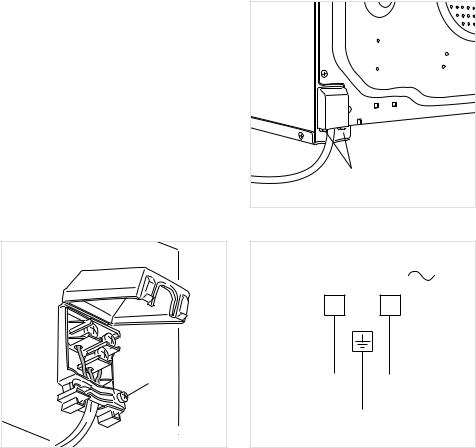
REPLACING THE POWER SUPPLY CABLE
Important! This appliance must be connected to the electricity supply only by an authorised person.
To connect the supply cable:
■■ Unhook the terminal board cover by inserting a screwdriver into the two hooks “A” (fig. 5).
■■ Open the cable gland by unscrewing screw “F” (fig. 6), unscrew the terminal screws and remove the cable.
■■ The new supply cable, of suitable type and section, is connected to the terminal board following the diagram fig. 7.
■■ Close and hook again the terminal board cover.
N.B. The earth conductor must be left about 3 cm longer than the others.
VOLTAGE AND POWER CONSUMPTION
220-240 V ac |
3095 W (13.45 A) |
Figure 5 |
|
|
FEEDER CABLE SECTION TYPE H05RR-F
3 x 1,5 mm2 (*) (**)
(*) Connection possible with plug and outlet (**) Connection with wall box connection.
A
Figure 6 |
Figure 7 |
|
220 - 240 V |
|
F |
L1 |
N (L2) |
|
||
|
|
E |
11
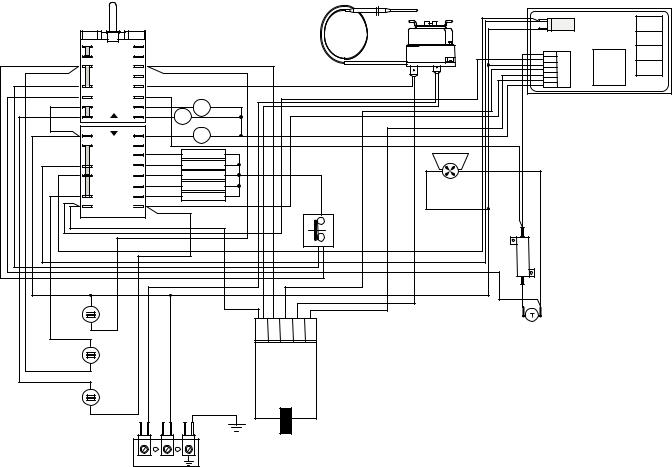
12 |
|
F1 |
|
|
|
|
TH |
PR |
|
|
|
|
|
|
|
|
|||
|
|
|
|
|
|
ST1 |
|
||
|
|
|
|
|
|
|
|
|
|
|
1a |
1 |
|
|
|
|
2 |
ST3 |
|
|
2a |
2 |
|
|
|
|
|
||
|
3a |
3 |
|
|
|
|
1 |
ST4 |
|
|
|
|
|
|
4 |
|
|||
|
|
|
|
|
|
|
3 |
|
|
|
|
4 |
|
|
|
|
5 |
|
|
|
5a |
5 |
|
|
|
|
6 |
|
|
|
|
|
|
|
7 |
|
|
||
|
6a |
6 |
|
V |
|
|
|
|
|
|
7a |
7 |
GIR |
|
|
|
|
|
|
|
8a |
8 |
|
|
|
|
|
||
|
9a |
9 |
|
LF |
|
|
|
|
|
|
10a |
10 |
|
CIR |
|
|
|
|
|
|
|
11 |
|
|
|
|
|
|
|
|
12a |
12 |
|
G |
|
|
|
8Figure |
DIAGRAMELECTRIC |
|
13a |
13 |
|
C |
|
|
CF |
||
|
|
14 |
S INT. |
|
|
|
|
||
|
15a |
|
S EXT. |
|
|
|
|
|
|
|
16a |
16 |
|
|
|
|
|
|
|
|
|
|
|
|
|
|
TL |
|
|
|
|
|
|
|
|
|
R |
|
|
1 |
ST |
|
|
34 33 4 |
3 |
2 |
TL1 |
|
|
|
|
|
|
|
|
|
|
||
|
|
|
|
|
|
DL |
|
|
|
|
SL |
|
|
|
|
|
|
|
|
S |
|
|
T |
|
|
|
|
|
|
|
|
M L |
N |
|
|
|
|
|
|
D
5
ELECTRIC DIAGRAM KEY
F1 Oven switch
TH Safety thermostat
ST1 Oven temperature sensor ST3 Oven door switch
ST4 Encoder switch PR Oven programmer TL Thermal overload TL1 Thermal overload
DL Door locking safety device CF Cooling fan motor
LF Oven lamp R Resistance
V Oven fan motor GIR Rotisserie motor
ST Thermostat pilot lamp SL Line pilot lamp
SD Door locking pilot lamp C Oven top element
G Oven grill element
S INT. Oven bottom element 1 S EXT. Oven bottom element 2 CIR Oven circular element M Terminal block
T Earth connection
13
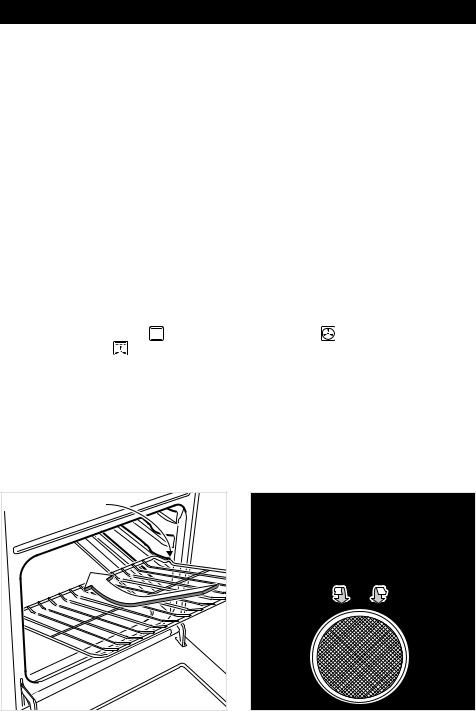
USE AND CARE
CAUTION:
■■ This appliance must be used only for the task it has explicitly been designed for, that is for domestic cooking of foodstuffs. Any other form of usage is to be considered as inappropriate and therefore dangerous.
■■ Do NOT place combustible materials or products on this appliance at any time.
USING THE OVEN FOR THE FIRST TIME
Operate as follows:
■■ Slide in the grease filter on the back of the oven as in fig. 10.
■■ Slide in, on the side formed runners, the shelves operating as per figure 9.
The oven shelves are provided with a security block to prevent accidental extraction. Keep attention to insert the shelves correctly.
To pull them out operate in the inverse order.
■■ Introduce the grill tray in the oven; it shall be placed above the shelf and it should be centered with the grill element (fig. 11). The tray does not fit into the side formed runners.
■■ To eliminate traces of grease in manufacture it is necessary to pre-heat the oven at the
maximum temperature: |
|
|
|
• For 60 minutes in the |
position, for 30 minutes in the |
position and for another 15 |
|
minutes in the |
position. |
|
|
■■ Let the oven cool down, switch off the electrical supply, then clean the inside of the oven with a cloth soaked in water and neutral detergent and dry thoroughly.
Important: Always use suitable protective gloves when inserting/removing the baking/grill tray, shelves, pans on other cooking utensils from the oven.
Figure 9 |
Figure 10 |
Safety catch |
14 |
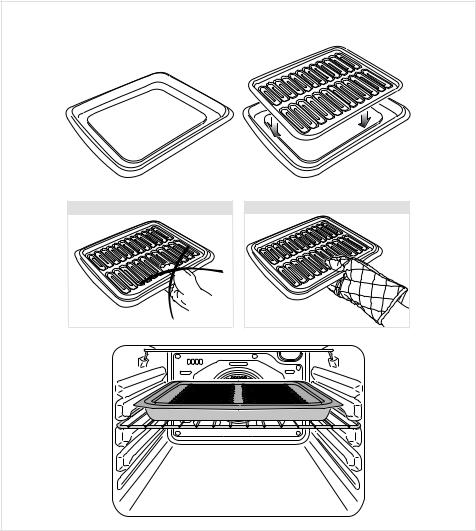
GREASE FILTER
■■ A special screen is provided at the back of the oven to catch grease particles, mainly when meat is being roasted.
■■ Clean the filter after any cooking! The grease filter can be removed for cleaning and should be washed regularly in hot soapy water (fig. 10).
■■ Always dry the filter properly before fitting it back into the oven. CAUTION: When baking pastry etc. this filter should be removed.
Figure 11 |
Grill tray (baking tray + grill |
|
|
|
grid fitted above) |
|
Baking tray |
WRONG |
CORRECT |
15
